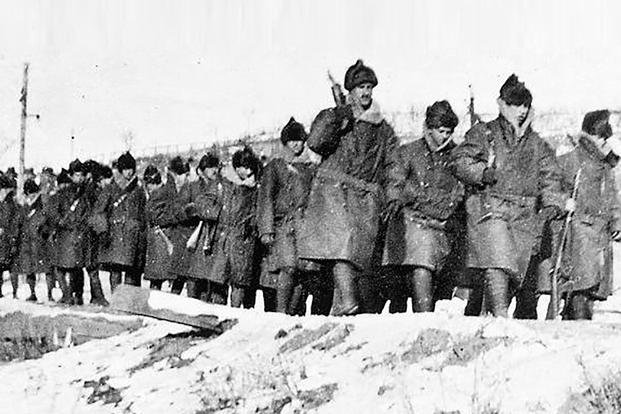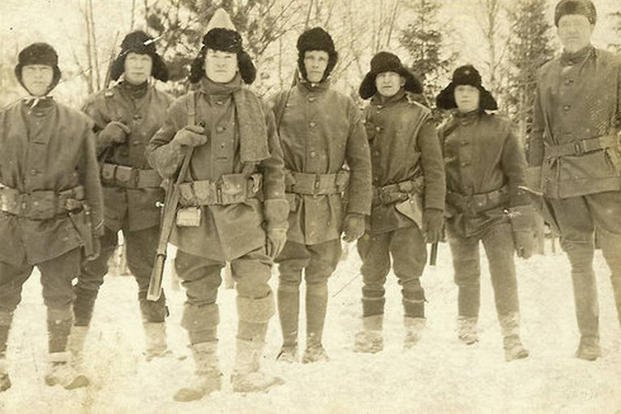A little over a century ago, the U.S. Army embarked on a little-remembered but ill-fated adventure that left the remains of 129 American servicemen on a frozen battlefield in the nascent Soviet Union.
Ten years later, the Veterans of Foreign Wars did what the U.S. government could not: Bring their war dead home.
One of the biggest recurring lessons from military history is not to invade Russia in the winter, but the United States did just that. In September 1918, American troops disembarked on the shores of the White Sea, 700 miles north of Moscow, to fight the Red Army on its home turf.
They were joined by contingents from Britain, France and nine other nations, hoping to defeat the Bolshevik Revolution in its infancy after the Russian Empire collapsed during the First World War.
It did not go the way the Allied Powers had hoped.
Now known as "The Polar Bear Expedition," the invasion of Russia was a disastrous departure from the muddy trenches of the Western Front. Some 13,000 U.S. soldiers fought Russian Red Armies on three fronts, cutting trenches into the permafrost holding the ports of Arkhangelsk and Vladivostok -- about 4,000 miles apart.
When the tsar's government fell, the Red Communists controlled only part of the former Russian Empire in Europe. Western liberals, capitalists and other democratic forces formed the White Russian Army to push the Red Army back into Asia and retake Moscow. It was on the side of the White Army that the tsar's former allies intervened.
The intervention had a military purpose for World War I. The Allies believe that restoring the Russian government would bring Russia back into the war and reopen the Eastern Front, forcing Germany to once again divide its forces.

But the war ended before the Polar Bear Expedition even came close to reaching its goals. After little more than a month fighting the Red Army, the Armistice was signed. Yet American and allied forces remained in Russia, even as the dreaded winter began to set in. Their lines were overextended by their British commander while guarding a railway that was vital for delivering coal to White forces.
Russian troops under the command of Leon Trotsky were able to wreak havoc on the stretched-out Americans and force their 130-mile retreat northward toward the White Sea. When they finally departed in June 1919 -- eight months after World War I ended -- no one in the unit knew exactly why they had been sent there.
What they did know is that more than 400 of them had died in Russia, and 129 of their fellow soldiers' remains were unaccounted for.
By 1929, the commander in chief of the Veterans of Foreign Wars was Eugene Carver Jr., a veteran of the Western Front. Polar Bear veterans approached Carver to find out what he could do to bring those 129 men home to rest. The VFW has always advocated for the return of fallen veterans' remains, but this would be the first time members of the group would personally travel to bring them back.
Carver and Secretary of War Patrick Hurley officially petitioned the government of the Soviet Union to repatriate the fallen remains, but that request was denied. The United States did not recognize the USSR as the official Russian government, and wouldn't until 1933. Relations between the two remained as frosty as the battlefields of Arkhangelsk.
But Carver would again approach Moscow with his request. This time, he did so as a private citizen on behalf of the VFW. The Soviet Union granted the VFW's request. After arriving in Moscow in August 1929, the USSR gave the VFW roughly 10 weeks to repatriate the remains.
The recovery team consisted of VFW members, archaeologists and former members of the Polar Bear Expedition, men who volunteered to go dig up their battle buddies and bring them home.
"We made our way up the rivers in wood-burning, flat-bottomed boats, drawing about a foot of water, a red-and-yellow VFW pennant flying from the mast," VFW National Legislative Chair and leader of the expedition Charles Bettelheim wrote. "A number of times, we slept on the banks of the river where we built bonfires -- it was better to sleep on the banks of the river than it was to attempt to sleep in the vermin-infested houses in the villages or cramped in our small boat."
The team found 88 of their own buried in swamps, cliffs and forests. They were even able to identify most of them. After departing from Leningrad on Oct. 27, 1929, 11 of the bodies were dropped off to be buried at American military cemeteries in France. The other 77 were taken to the U.S., landing in Hoboken, New Jersey, a month later. They arrived to a 17-gun salute.
There, 17 sets of remains were interred at Arlington National Cemetery. The rest were put aboard a funeral train on their way back to Michigan. "Detroit's Own" were finally home.
According to the VFW, 88 members of the Polar Bear Expedition were returned to the United States. Another 14 were recovered by the Army in 1934. The others were never found.
-- Blake Stilwell can be reached at blake.stilwell@military.com.
Want to Know More About Military History?
Be sure to get the best, most compelling stories of military history as well as critical info about how to join and all the benefits of service. Subscribe to Military.com and receive customized updates delivered straight to your inbox.
















